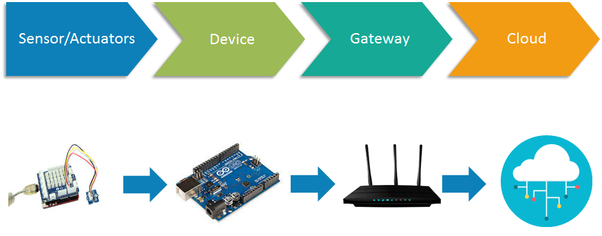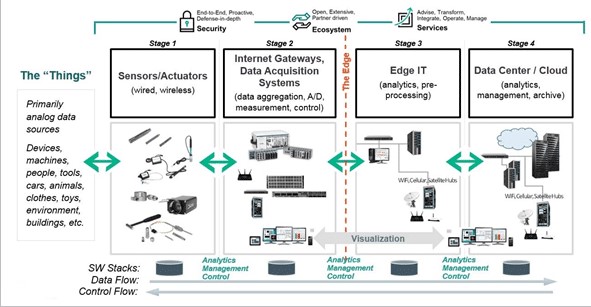What is IoT: Its use in the 21st century.

There was a lot of talk going on in the tech labs of a thing called IoT, the conversations would happen behind closed walls and even a peak of the conversation would leave the general man baffled by the technical jargon. It was after tests were done that this “creature” found its way into the market as a numerous range of products available to the general man off the shelf with a set of instructions for setting up and they called it IoT.
Dear reader, in this article I will expound on what IoT is in the simplest of language to help you understand what it’s all about. Read every line in order not to get baffled next time “IoT” pops up in class, in a meeting, conference or on TV, yeah?
What is IoT?
The acronym IoT stands for Internet of Things, yes that’s just what it stands for. IoT is a network of physical objects: vehicles, machines, home appliances, smart phones and more that use sensors and a link for connection called an API to connect and exchange data over the Internet without requiring human-to-human or human-to-computer interaction.
Let’s take a quick example to help you better understand; say you work for 12 hours a day, you live alone in an apartment. One day when you get home you realise that you don’t have anything in the fridge to cook because you forgot to buy.
Now here is where IoT comes in, think of an IoT enabled refrigerator which keeps a track of all food items available in your fridge. When it notices that you are out of meat, veggies and milk, it automatically orders the items online and makes the payment for you. If you forget to buy food, your refrigerator will do the shopping for you. Isn’t this fantastic?
Birth of IoT
The internet started with a simple idea of connecting computers together to share data in various ways, since then, people have started buying smart devices that can connect to the Internet. That’s the basis of the term Internet of Things (IoT). The Internet of Things extends internet connectivity beyond traditional devices like desktop and laptop computers, smartphones and tablets to an ever-growing network of everyday things that utilise embedded technology to communicate and interact with the external environment, all via the Internet. It’s the inter-networking of physical devices (“connected devices” and “smart devices”) that enable these objects to collect and exchange data.
IoT products are being developed everywhere. Companies like INTEL, LG, Microsoft too many start-ups are working on this technology. This technology is being researched for areas like home automation, medicine, agriculture, education and many more.
Architecture of IoT
IoT platform is a cloud software/platform that connects to the sensors, gateways, end-user applications or any other physical thing that has a network connectivity and is an integral component of IoT architecture.
IoT architecture is basically an intrinsic structure or skeleton of an IoT enabled product. There are four primary components of an IoT architecture:-

- Device Hardware – A device must have the required hardware that enables it to connect to and communicate with the Internet. Requires an idea of architecture and working of various micro-processors along with various sensors.
- Device Software and protocol – A protocol is simply a set of rules. In this case, the rules determine how the communication between two devices occurs. Examples of protocols used for IoT include SOAP and REST plus the underlying protocols, such as HTTP. Requires writing computer programs to configure your micro-processor and make it act accordingly. Also requires knowledge for how API’s work inside micro-processors and how you can make libraries for programming to lessen the work.
- Communication and Cloud Platform – When working in the cloud, it’s still necessary to have a place to store information of various sorts. It is also important to provide the devices with access points. Knowledge on wired and wireless communication is also required. The cloud in itself is an indispensable part of IoT and requires knowledge for how Cloud technology works and its integration with IoT.
- Cloud Software/Application – The software used to actually cause the interaction between devices determines what functionality the devices ultimately provide (within their range of possible actions). It serves the purpose of improving our ability to use the system to maximum potential.
How does it work?
It isn’t possible to simply connect a device to the Internet and have it miraculously start communicating with other connected devices. The Internet of Things requires that you have the basic pieces in place.
IoT platforms provide data security involving encryption, comprehensive identity management, end-to-end data flow encryption, device authentication, user access rights management, and private cloud infrastructure for sensitive data to avoid potentially compromising breaches.

Stage 1:
- Sensors: Sensors collect data from the environment or object under measurement and turn it into useful data.
For example: gyroscope in mobiles - Actuators: Actuators can also intervene to change the physical conditions that generate the data.
An actuator might, for example, shut off a power supply, adjust an air flow valve, or move a robotic gripper in an assembly process. - Example: A fire detection system: – the sensor detects smoke and sounds an alarm to alert building occupants of a potential fire hazard. The actuator will adjust a water valve to the open position and the water sprinklers begin to put out the fire. Understandable right?
Stage 2:
The stage 2 systems often exist in close vicinity to the sensors and actuators.
For Example: A pump might contain a series of sensors and actuators that feed data into a data aggregation device that also digitises the data. This device might be physically attached to the pump. An adjacent gateway device or server would then process the data and forward it to the Stage 3 or Stage 4 systems.
Stage 3:
- Once IoT data has been digitised and aggregated, it’s ready to cross into the realm of IT.
- However, the data may require further processing before it enters the data centre
- This is where edge IT systems, which perform more analysis, come into play
- Edge IT processing systems may be located in remote offices or other edge locations, but generally these sit in the facility or location where the sensors reside closer to the sensors, such as in a wiring closet.
Stage 4:
- The data from Stage 3 is forwarded to physical data centre or cloud-based systems, where more powerful IT systems can analyse, manage, and securely store the data
- It takes longer to get results when you wait until data reaches Stage 4, but you can execute a more in-depth analysis, as well as combine your sensor data with data from other sources for deeper insights.
- Stage 4 processing may take place on-premises, in the cloud, or in a hybrid cloud system, but the type of processing executed in this stage remains the same, regardless of the platform.
Applications of IoT
The ability to network embedded devices with limited CPU, memory and power resources means that Internet of Things (IoT) finds applications in nearly every field. Below are a few examples:-
- Home automation (also known as smart home devices) such as the control and automation of lighting, ventilation, air conditioning , robotic vacuums, air purifiers, ovens or refrigerators that use Wi-Fi for remote monitoring.
- Wearable Technology which includes smart watches, fitness trackers, virtual reality headsets and more.
- Environment IoT application technologies that have sensors can be used to monitor air and water quality, soil or atmospheric conditions, and even the movements of wildlife. The IoT devices can also be used in applications such as tsunami early-warning systems to help authorities offer more effective responses and aid.
- Utilities doing real time grid assessment from devices sitting on the grid mainly used by utility companies.
- Logistics firms designing real-time tracking via GPS of precise location, time, speed and condition of cargo in transit.
- Infrastructure: IoT can also be applied to monitor and control operations of urban and rural infrastructure such as bridges and railway tracks. IoT can help to schedule repair and maintenance activities in a well-organised manner.
- Manufacturers predicting when equipment will need maintenance or service.
- Insurers increasing revenue through asset monitoring.
- Medical and Healthcare: IoT devices that enable remote health monitoring and emergency notification systems such as blood pressure and heart rate monitors.
- Banks providing better offers and more engagement via tellers and ATM’s that are intuitive.
However, the application of IoT is not only restricted to these areas. Other specialised use cases of IoT may also exist, share some that you know or have seen with us in the comment section.
This is pretty much about it on ” What is IoT” without getting too much into technical details. A lot of stuff i left out from this article that may apply to individuals who inspire to work with IoT. Watch out for the next article covering the future of the world with IoT unpacked as well as a fun space where we uncover the multiple times you may have used IoT without realising it. See you on the next one reader and remember to drop questions and contributions in the comment section.
